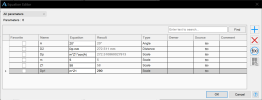stepalibre
Alibre Super User
Yes, and this is often more efficient and faster than generating from scratch every time, even if the features do exist.especially when there are features needed that are not part of the standard API
Yes, and this is often more efficient and faster than generating from scratch every time, even if the features do exist.especially when there are features needed that are not part of the standard API
This is the key to the whole problem.Units are variables:
View attachment 41298
(m*Z1)/200 which is actually (1000 * 58)/200 which equals 290(m*Z1) to be (5 * 58) which equals 290. But the variable m is 1000 instead of 5, so the equation has to be divided by 200 to get the correct result because 1000/200 = 5.I would expect "m" to equal 5 as it is assigned a new value [ * ]. If you make a parameter named "m" with a value of 5, "m" should equal 5. The editor should not allow unit variables/constants to be used as parameter names if they cannot be reassigned a new value.Alibre's "m" is 1000 mm which overrides any user variable of the same name.
This is the key to the whole problem.
The OP has a variable named "m" which conflicts with Alibre's "m" variable. Alibre's "m" is 1000 mm which overrides any user variable of the same name.
Equation Dp1 is:(m*Z1)/200which is actually(1000 * 58)/200which equals290
The OP expects:(m*Z1)to be(5 * 58)which equals290. But the variablemis1000instead of5, so the equation has to be divided by200to get the correct result because1000/200 = 5.

I'm pretty sure if you just change that variable "m" to something else it will fix the main issue you are having. I updated the equations as shown and your gear stayed the same. This should at least help the equations be more straightforward.Let me give you an example of what I intend to do. In the end I can get the result I want. But you have to apply a number of scale factors that don't make any sense to me.
I have traced the flank of the tooth using Grant's method. As the gear has more than 34 teeth, it can be made with a single radius (RU)
I have used the European modulus system instead of the "diametrical pitch" used in the US and UK
I will study all the information you have kindly provided, to see what I can optimize.
This shouldn't be required but it is for Alibre's equation editor. I have MathCAD and Smath studio calculations that use "m" that I don't want to change. I can update or have an alias but I'd rather not, they work fine in SolidWorks.I'm pretty sure if you just change that variable "m" to something else it will fix the main issue you are having. I updated the equations as shown and your gear stayed the same. This should at least help the equations be more straightforward.
So your advice is to do all calculations in Scale type parameters and then reference those in Distance type parameters to avoid the units and reserved parameter name issues. This sounds like a good practice. I've always just used Distance and been frustrated when I ran into weird glitches which were only solved by putting units into the equations. This discussion has been helpful, thanks!This shouldn't be required but it is for Alibre's equation editor. I have MathCAD and Smath studio calculations that use "m" that I don't want to change. I can update or have an alias but I'd rather not, they work fine in SolidWorks.
It's safe to use any parameter name (that is allowed) as long as you don't make it a Distance type which is the cause of other problems as well as this issue.

Very interesting utilities. Your in-depth knowledge of the program is evident ;-)Save some time... Download my gear generator - it's part of the Utilities for Alibre Add-on.
https://www.alibre.com/forum/index.php?resources/utilities-for-alibre.125/
I understand your pain with the equation editor!
David
